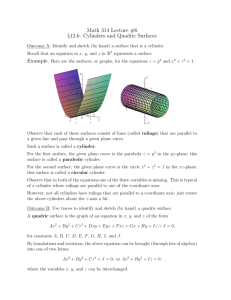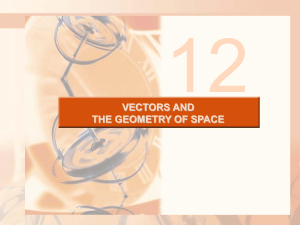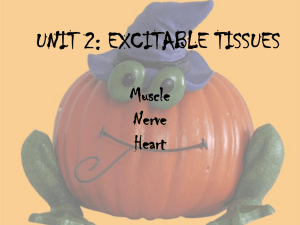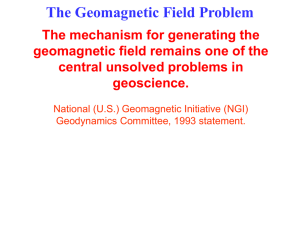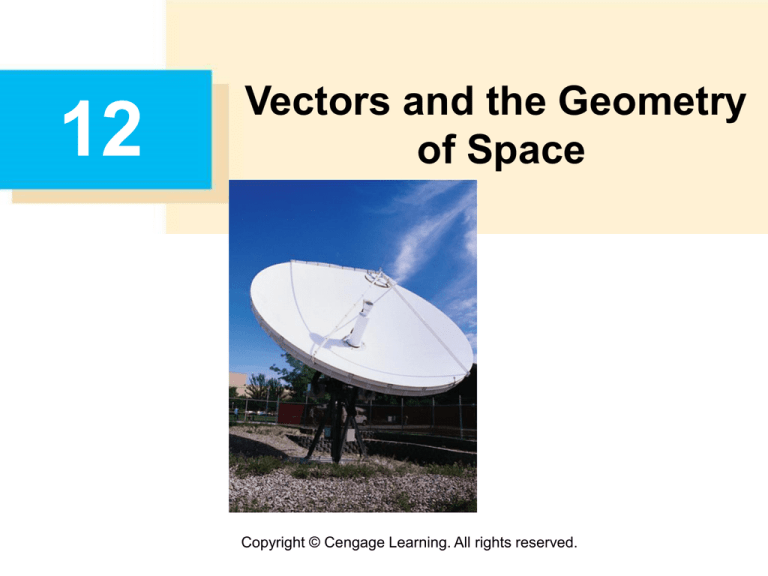
12
Vectors and the Geometry
of Space
Copyright © Cengage Learning. All rights reserved.
12.6
Cylinders and Quadric Surfaces
Copyright © Cengage Learning. All rights reserved.
Cylinders and Quadric Surfaces
We have already looked at two special types of surfaces:
planes and spheres.
Here we investigate two other types of surfaces: cylinders
and quadric surfaces: cylinders and quadric surfaces.
In order to sketch the graph of a surface, it is useful to
determine the curves of intersection of the surface with
planes parallel to the coordinate planes.
These curves are called traces (or cross-sections) of the
surface.
3
Cylinders
4
Cylinders
A cylinder is a surface that consists of all lines
(called rulings) that are parallel to a given line and pass
through a given plane curve.
5
Example 1
Sketch the graph of the surface z = x2.
Solution:
Notice that the equation of the graph, z = x2, doesn’t
involve y.
This means that any vertical plane with equation
y = k(parallel to the xz-plane) intersects the graph in a
curve with equation z = x2.
So these vertical traces are parabolas.
6
Example 1 – Solution
cont’d
Figure 1 shows how the graph is formed by taking the
parabola z = x2 in the xz-plane and moving it in the
direction of the y-axis.
The graph is a surface, called
a parabolic cylinder, made
up of infinitely many shifted
copies of the same parabola.
Here the rulings of the cylinder
are parallel to the y-axis.
The surface z = x2 is a parabolic cylinder.
Figure 1
7
Cylinders
We noticed that the variable y is missing from the equation
of the cylinder in Example 1. This is typical of a surface
whose rulings are parallel to one of the coordinate axes.
If one of the variables x, y or z is missing from the equation
of a surface, then the surface is a cylinder.
Note:
When you are dealing with surfaces, it is important to
recognize that an equation like x2 + y2 = 1 represents a
cylinder and not a circle. The trace of the cylinder
x2 + y2 = 1 in the xy-plane is the circle with equations
x2 + y2 = 1, z = 0.
8
Quadric Surfaces
9
Quadric Surfaces
A quadric surface is the graph of a second-degree
equation in three variables x, y, and z. The most general
such equation is
Where A,B,C,…, J are constants, but by translation and
rotation it can be brought into one of the two standard
forms
Ax2 + By2 + Cz2 + J = 0
or
Ax2 + By2 + Iz = 0
Quadric surfaces are the counterparts in three dimensions
of the conic sections in the plane.
10
Example 3
Use traces to sketch the quadric surface with equation
Solution:
By substituting z = 0, we find that the trace in the xy-plane
is x2 + y2 /9 = 1, which we recognize as an equation of an
ellipse. In general, the horizontal trace in the plane z = k is
which is an ellipse, provided that k2 < 4, that is, –2 < k < 2.
11
Example 3 – Solution
cont’d
Similarly, the vertical traces are also ellipses:
(if –1 < k < 1)
(if –3 < k < 3)
12
Example 3 – Solution
cont’d
Figure 4 shows how drawing some traces indicates the
shape of the surface.
It’s called an ellipsoid because all of its traces are ellipses.
Notice that it is symmetric with
respect to each coordinate plane;
this is a reflection of the fact that
its equation involves only even
powers of x, y, and z.
The ellipsoid
Figure 4
13
Example 4
Use traces to sketch the surface z = 4x2 + y2.
Solution:
If we put x = 0, we get z = y2, so the yz-plane intersects the
surface in a parabola. If we put x = k (a constant), we get
z = y2 + 4k2.
This means that if we slice the graph with any plane
parallel to the yz-plane, we obtain a parabola that opens
upward.
Similarly, if y = k, the trace is z = 4x2 + k2, which is again a
parabola that opens upward.
14
Example 4 – Solution
cont’d
If we put z = k, we get the horizontal traces 4x2 + y2 = k,
which we recognize as a family of ellipses. Knowing the
shapes of the traces, we can sketch the graph in Figure 5.
The surface z = 4x2 + y2 is an elliptic paraboloid. Horizontal
traces are ellipses; vertical traces are parabolas.
Figure 5
Because of the elliptical and parabolic traces, the quadric
surface z = 4x2 + y2 is called an elliptic paraboloid.
15
Example 5
Sketch the surface z = y2 – x2.
Solution:
The traces in the vertical planes x = k are the parabolas
z = y2 – k2, which open upward. The traces in y = k are the
parabolas z = –x2 + k2, which open downward.
The horizontal traces are y2 – x2 = k, a family of hyperbolas.
16
Example 5 – Solution
cont’d
We draw the families of traces in Figure 6, and we show
how the traces appear when placed in their correct planes
in Figure 7.
Traces in x = k
are z = y2 – k2
Traces in y = k
are z = –x2 + k2
Traces in z = k
are y2 – x2 = k
Vertical traces are parabolas; horizontal traces are
hyperbolas. All traces are labeled with the value of k.
Figure 6
17
Example 5 – Solution
Traces in x = k
Traces in y = k
cont’d
Traces in z = k
Traces moved to their correct planes
Figure 7
18
Example 5 – Solution
cont’d
In Figure 8 we fit together the traces from Figure 7 to form
the surface z = y2 – x2, a hyperbolic paraboloid.
The surface z = y2 – x2 is a hyperbolic paraboloid.
Figure 8
Notice that the shape of the surface near the origin
resembles that of a saddle.
19
Example 6
Sketch the surface
Solution:
The trace in any horizontal plane z = k is the ellipse
z=k
but the traces in the xz- and yz-planes are the hyperbolas
y=0
and
x=0
20
Example 6 – Solution
cont’d
This surface is called a hyperboloid of one sheet and is
sketched in Figure 9.
Figure 9
21
Quadric Surfaces
The idea of using traces to draw a surface is employed in
three-dimensional graphing software for computers.
In most such software, traces in the vertical planes x = k
and y = k are drawn for equally spaced values of k, and
parts of the graph are eliminated using hidden line removal.
22
Quadric Surfaces
Table 1 shows
computer-drawn
graphs of the six
basic types of quadric
surfaces in standard
form.
All surfaces are
symmetric with respect
to the z-axis.
If a quadric surface is
symmetric about a different
axis, its equation changes
accordingly.
Graphs of quadric surfaces
Table 1
23
Applications of Quadric Surfaces
24
Applications of Quadric Surfaces
Examples of quadric surfaces can be found in the world
around us. In fact, the world itself is a good example.
Although the earth is commonly modeled as a sphere, a
more accurate model is an ellipsoid because the earth’s
rotation has caused a flattening at the poles.
Circular paraboloids, obtained by rotating a parabola about
its axis, are used to collect and reflect light, sound, and
radio and television signals.
25
Applications of Quadric Surfaces
In a radio telescope, for instance, signals from distant stars
that strike the bowl are all reflected to the receiver at the
focus and are therefore amplified.
The same principle applies to microphones and satellite
dishes in the shape of paraboloids.
Cooling towers for nuclear reactors are usually designed in
the shape of hyperboloids of one sheet for reasons of
structural stability.
Pairs of hyperboloids are used to transmit rotational motion
between skew axes.
26

